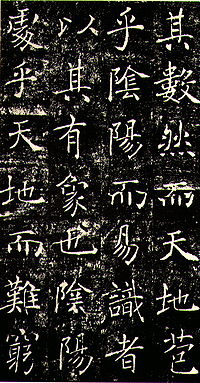
Regular script
Encyclopedia
Regular script also called 正楷 , 真書 (zhēnshū), 楷体 (kǎitǐ) and 正書 (zhèngshū), is the newest of the Chinese script styles (appearing by the Cao Wei
dynasty ca. 200 CE and maturing stylistically around the 7th century), hence most common in modern writings and publications (after the Ming and sans-serif styles, used exclusively in print).

 Regular script came into being between the Eastern Hàn and Cáo Wèi
Regular script came into being between the Eastern Hàn and Cáo Wèi
dynasties, and its first known master was Zhōng Yáo
(sometimes also read Zhōng Yóu; 鍾繇), who lived in the E. Hàn to Cáo Wèi period, ca. 151–230 CE. He is known as the “father of regular script”, and his famous works include the Xuānshì Biǎo (宣示表), Jiànjìzhí Biǎo (薦季直表), and Lìmìng Biǎo (力命表). Qiú Xīguī describes the script in Zhong’s Xuānshì Biǎo as:
However, other than a few literati, very few wrote in this script at the time; most continued writing in neo-clerical script, or a hybrid form of semi-cursive and neo-clerical. Regular script did not become dominant until the early Southern and Northern Dynasties
, in the 5th century; this was a variety of regular script which emerged from neo-clerical as well as from Zhong Yao's regular script, and is called "Wei regular" (魏楷 Weikai). Thus, regular script has parentage in early semi-cursive as well as neo-clerical scripts.
The script is considered to have matured stylistically during the Tang Dynasty
, with the most famous and oft-imitated regular script calligraphers of that period being:
are said to contain a variety of most of the strokes found in regular script.
Notable writings in regular script include:
Cao Wei
Cao Wei was one of the states that competed for control of China during the Three Kingdoms period. With the capital at Luoyang, the state was established by Cao Pi in 220, based upon the foundations that his father Cao Cao laid...
dynasty ca. 200 CE and maturing stylistically around the 7th century), hence most common in modern writings and publications (after the Ming and sans-serif styles, used exclusively in print).
History


Cao Wei
Cao Wei was one of the states that competed for control of China during the Three Kingdoms period. With the capital at Luoyang, the state was established by Cao Pi in 220, based upon the foundations that his father Cao Cao laid...
dynasties, and its first known master was Zhōng Yáo
Zhong Yao
Zhong Yao was a Chinese calligrapher and politician of Cao Wei during the late Han Dynasty and Three Kingdoms period of Chinese history. Born in modern Xuchang, Henan, he was at one time the Grand Administrator of Chang'an....
(sometimes also read Zhōng Yóu; 鍾繇), who lived in the E. Hàn to Cáo Wèi period, ca. 151–230 CE. He is known as the “father of regular script”, and his famous works include the Xuānshì Biǎo (宣示表), Jiànjìzhí Biǎo (薦季直表), and Lìmìng Biǎo (力命表). Qiú Xīguī describes the script in Zhong’s Xuānshì Biǎo as:
However, other than a few literati, very few wrote in this script at the time; most continued writing in neo-clerical script, or a hybrid form of semi-cursive and neo-clerical. Regular script did not become dominant until the early Southern and Northern Dynasties
Southern and Northern Dynasties
The Southern and Northern Dynasties was a period in the history of China that lasted from 420 to 589 AD. Though an age of civil war and political chaos, it was also a time of flourishing arts and culture, advancement in technology, and the spreading of Mahayana Buddhism and Daoism...
, in the 5th century; this was a variety of regular script which emerged from neo-clerical as well as from Zhong Yao's regular script, and is called "Wei regular" (魏楷 Weikai). Thus, regular script has parentage in early semi-cursive as well as neo-clerical scripts.
The script is considered to have matured stylistically during the Tang Dynasty
Tang Dynasty
The Tang Dynasty was an imperial dynasty of China preceded by the Sui Dynasty and followed by the Five Dynasties and Ten Kingdoms Period. It was founded by the Li family, who seized power during the decline and collapse of the Sui Empire...
, with the most famous and oft-imitated regular script calligraphers of that period being:
- The early Tang four great calligraphers (初唐四大家):
- Ouyang XunOuyang XunOuyang Xun , courtesy name Xinben , was a Confucian scholar and calligrapher of the early Tang Dynasty. He was born in Hunan, Changsha, to a family of government officials; and died in modern Anhui province.-Achievements:...
(欧阳询) - Yu ShinanYu ShinanYu Shinan , courtesy name Boshi , was a master of calligraphy in early Tang Dynasty. He was also a paramount official, litterateur and well known confucian scholar in Emperor Taizong of Tang's era....
(虞世南) - Chu SuiliangChu SuiliangChu Suiliang , courtesy name Dengshan , formally Duke of Henan , was a chancellor of the Chinese dynasty Tang Dynasty, during the reigns of Emperor Taizong and Emperor Taizong's son Emperor Gaozong...
(褚遂良) - Xue JiXue JiXue Ji , courtesy name Sitong , was an official of the Chinese Tang Dynasty, briefly serving as chancellor during the reign of Emperor Ruizong. He was considered one of the four greatest calligraphers of early Tang, along with Yu Shinan, Ouyang Xun, and Chu Suiliang.-Background:Xue Ji was born in...
(薛稷)
- Ouyang Xun
- "Yan-Liu" ("顏柳")
- Yan ZhenqingYan ZhenqingYan Zhenqing was a leading Chinese calligrapher and a loyal governor of the Tang Dynasty. His artistic accomplishment in Chinese calligraphy parallels the greatest master calligraphers throughout the history, and his regular script style, Yan, is often imitated.-Early life:Yan Zhenqing was born...
(颜真卿) - Liu GongquanLiu GongquanLiu Gongquan , courtesy name Chengxuan , was a Chinese calligrapher who stood with Yan Zhenqing as the two great masters of late Tang calligraphy....
(柳公权)
- Yan Zhenqing
Characteristics
Regular script characters with width (or length) larger than 5 cm (2 in) is usually considered larger regular script, or dakai (大楷), and those smaller than 2 cm (0.8 in) usually small regular script, or xiaokai (小楷). Those in between are usually called medium regular script, or zhongkai (中楷). What these are relative to other characters. The Eight Principles of YongEight Principles of Yong
Stroke order animated and in color gradation from black to red The strokes numbered Where there are multiple numbers in an area, the strokes overlap briefly and continue from the previous number to the next....
are said to contain a variety of most of the strokes found in regular script.
Notable writings in regular script include:
- The Records of Yao Boduo Sculpturing (姚伯多造像記) during the Southern and Northern DynastiesSouthern and Northern DynastiesThe Southern and Northern Dynasties was a period in the history of China that lasted from 420 to 589 AD. Though an age of civil war and political chaos, it was also a time of flourishing arts and culture, advancement in technology, and the spreading of Mahayana Buddhism and Daoism...
- The Tablet of Guangwu General (廣武將軍碑) during the Southern and Northern DynastiesSouthern and Northern DynastiesThe Southern and Northern Dynasties was a period in the history of China that lasted from 420 to 589 AD. Though an age of civil war and political chaos, it was also a time of flourishing arts and culture, advancement in technology, and the spreading of Mahayana Buddhism and Daoism...
- The Tablet of Longzang Temple (龍藏寺碑) of the Sui DynastySui DynastyThe Sui Dynasty was a powerful, but short-lived Imperial Chinese dynasty. Preceded by the Southern and Northern Dynasties, it ended nearly four centuries of division between rival regimes. It was followed by the Tang Dynasty....
- Tombstone-Record of Sui Xiaoci (蘇孝慈墓誌) of the Sui Dynasty
- Tombstone-Record of Beauty Tong (董美人墓誌) of the Sui Dynasty
- Sweet Spring at Jiucheng Palace (九成宮醴泉銘) of the Tang DynastyTang DynastyThe Tang Dynasty was an imperial dynasty of China preceded by the Sui Dynasty and followed by the Five Dynasties and Ten Kingdoms Period. It was founded by the Li family, who seized power during the decline and collapse of the Sui Empire...
Derivatives
- Imitation Song typefaceImitation Song typefaceImitation Song is a style of Chinese typefaces modeled after a type style in Lin'an in the Southern Song Dynasty. They are technically a type of regular script typeface.-Name:...
s are typefaces based on a printed style which developed in the Song dynastySong DynastyThe Song Dynasty was a ruling dynasty in China between 960 and 1279; it succeeded the Five Dynasties and Ten Kingdoms Period, and was followed by the Yuan Dynasty. It was the first government in world history to issue banknotes or paper money, and the first Chinese government to establish a...
, from which Ming typefaces developed. - The most common printed typeface styles Ming and sans-serif are based on the structure of regular script.
- The Japanese textbook typefaces ' onMouseout='HidePop("19136")' href="/topics/Hepburn_romanization">HepburnHepburn romanizationThe is named after James Curtis Hepburn, who used it to transcribe the sounds of the Japanese language into the Latin alphabet in the third edition of his Japanese–English dictionary, published in 1887. The system was originally proposed by the in 1885...
: kyōkashotai) are based on regular script, but modified so that they appear to be written with a pencilPencilA pencil is a writing implement or art medium usually constructed of a narrow, solid pigment core inside a protective casing. The case prevents the core from breaking, and also from marking the user’s hand during use....
or penPenA pen is a device used to apply ink to a surface, usually paper, for writing or drawing. Historically, reed pens, quill pens, and dip pens were used, with a nib of some sort to be dipped in the ink. Ruling pens allow precise adjustment of line width, and still find a few specialized uses, but...
. They also follow the standardized character forms prescribed in the Jōyō kanjiJoyo kanjiThe is the guide to kanji characters announced officially by the Japanese Ministry of Education. Current jōyō kanji are those on a list of 2,136 characters issued in 2010...
. - Zhuyin Fuhao characters, although not true Chinese characters, are virtually always written with regular script strokes.
External links
- Regular Script "tao te king" CHAPTER LVII
- More on Standard Script In English, at BeyondCalligraphy.com

